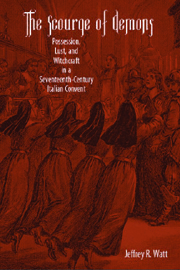Book contents
- Frontmatter
- Contents
- List of Illustrations
- Acknowledgments
- Introduction: Nuns, Witchcraft, and the Inquisition
- Chapter 1 Female Religious, Claustration, and Santa Chiara of Carpi
- Chapter 2 The Outbreak and Maleficia
- Chapter 3 The Confessor and Love Magic
- Chapter 4 The Exorcists and the Demons
- Chapter 5 Sisters Dealta and Ippolita under Attack
- Chapter 6 Bellacappa's Defense
- Chapter 7 The Waning of the Possessions
- Conclusion
- Appendix A
- Appendix B
- List of Abbreviations
- Notes
- Selected Bibliography
- Index
Introduction: Nuns, Witchcraft, and the Inquisition
Published online by Cambridge University Press: 12 September 2012
- Frontmatter
- Contents
- List of Illustrations
- Acknowledgments
- Introduction: Nuns, Witchcraft, and the Inquisition
- Chapter 1 Female Religious, Claustration, and Santa Chiara of Carpi
- Chapter 2 The Outbreak and Maleficia
- Chapter 3 The Confessor and Love Magic
- Chapter 4 The Exorcists and the Demons
- Chapter 5 Sisters Dealta and Ippolita under Attack
- Chapter 6 Bellacappa's Defense
- Chapter 7 The Waning of the Possessions
- Conclusion
- Appendix A
- Appendix B
- List of Abbreviations
- Notes
- Selected Bibliography
- Index
Summary
Today in the northern Italian city of Carpi, a small group of nuns pursue a quiet life of prayer and reflection in the Franciscan convent of Santa Chiara, located just a couple blocks to the northeast of the charming central plaza, site of the cathedral and the imposing Pio Castle (see fig. 1). In the seventeenth century, Santa Chiara was one of the most renowned nunneries in the duchy of Modena and the region of Emilia. A small town of about 3,600 inhabitants in the mid-1600s, Carpi had a very strong monastic presence with four monasteries and two convents, the most prestigious of which was Santa Chiara. This convent belonged to the order founded in the thirteenth century by Clare of Assisi. Inspired by Saint Francis, Clare and her early followers sought to pursue a life of “perfect poverty” and refused to own any property either individually or collectively. Canonized in 1255, two years after her death, Clare inspired generations of women to join this Second Order of St. Francis, whose members came to be known as the Clarisses or the Poor Clares.
The lifestyle of the Clarisses in seventeenth-century Carpi was far removed from that of Clare. The monastery of Santa Chiara was founded in 1490 by Camilla Pio (1440–1504), the grandniece of Pope Innocent VII (pontificate, 1404–06) and a member of the Pio family who ruled Carpi for generations until the 1520s.
- Type
- Chapter
- Information
- The Scourge of DemonsPossession, Lust, and Witchcraft in a Seventeenth-Century Italian Convent, pp. 1 - 20Publisher: Boydell & BrewerPrint publication year: 2009



